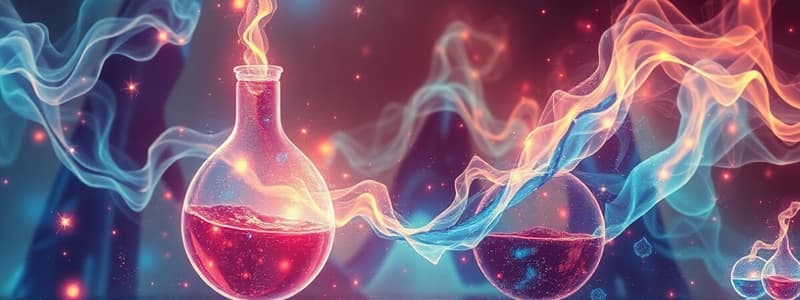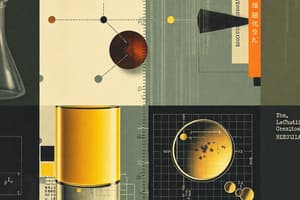Podcast
Questions and Answers
What happens to a reaction if Q is less than K?
What happens to a reaction if Q is less than K?
- The reaction is at equilibrium.
- The reaction shifts to the right. (correct)
- No change occurs.
- The reaction shifts to the left.
According to Le Chatelier’s Principle, increasing the concentration of reactants will favor the formation of products.
According to Le Chatelier’s Principle, increasing the concentration of reactants will favor the formation of products.
True (A)
When the reaction quotient Qc is greater than Kc, the reaction will shift to the _____ to reach equilibrium.
When the reaction quotient Qc is greater than Kc, the reaction will shift to the _____ to reach equilibrium.
left
Match the following factors to their effects on equilibrium:
Match the following factors to their effects on equilibrium:
What is the effect of increasing the pressure on the equilibrium position of the reaction PCl3 (g) + Cl2 (g) ⇌ PCl5 (g) based on Le Chatelier's Principle?
What is the effect of increasing the pressure on the equilibrium position of the reaction PCl3 (g) + Cl2 (g) ⇌ PCl5 (g) based on Le Chatelier's Principle?
An increase in temperature for an exothermic reaction will shift the equilibrium to the right.
An increase in temperature for an exothermic reaction will shift the equilibrium to the right.
In the context of the Haber Process, what are the main product and reactants involved?
In the context of the Haber Process, what are the main product and reactants involved?
According to Le Chatelier's Principle, if the concentration of Cl2 is increased, the reaction will shift to the ______ to counteract the change.
According to Le Chatelier's Principle, if the concentration of Cl2 is increased, the reaction will shift to the ______ to counteract the change.
Match the following factors with their effects on equilibrium position:
Match the following factors with their effects on equilibrium position:
What effect does adding heat have on an exothermic reaction at equilibrium?
What effect does adding heat have on an exothermic reaction at equilibrium?
Adding an inert gas at constant volume affects the equilibrium position of a reaction.
Adding an inert gas at constant volume affects the equilibrium position of a reaction.
In the reaction N2O4 (g) ⇌ 2 NO2 (g), what happens when the temperature is increased?
In the reaction N2O4 (g) ⇌ 2 NO2 (g), what happens when the temperature is increased?
In an exothermic reaction, increasing the temperature will cause the equilibrium to shift to the ______.
In an exothermic reaction, increasing the temperature will cause the equilibrium to shift to the ______.
Match each substance with its property in equilibrium:
Match each substance with its property in equilibrium:
Which of the following statements about catalysts in chemical equilibrium is true?
Which of the following statements about catalysts in chemical equilibrium is true?
What occurs when CO2 is added to the equilibrium reaction H2 (g) + CO2 (g) ⇌ H2O (g) + CO (g)?
What occurs when CO2 is added to the equilibrium reaction H2 (g) + CO2 (g) ⇌ H2O (g) + CO (g)?
The value of Kc for an exothermic reaction increases with increasing temperature.
The value of Kc for an exothermic reaction increases with increasing temperature.
Flashcards
Qc < Kc
Qc < Kc
When the reaction quotient (Qc) is less than the equilibrium constant (Kc), the reaction will proceed forward to produce more products.
Reaction quotient (Qc)
Reaction quotient (Qc)
A ratio of products to reactants at any given time during a reaction. It helps assess whether a reaction is at equilibrium.
Equilibrium constant (Kc)
Equilibrium constant (Kc)
A constant value that represents the ratio of products to reactants at equilibrium.
Le Chatelier's Principle
Le Chatelier's Principle
Signup and view all the flashcards
Reaction shifts right (forward)
Reaction shifts right (forward)
Signup and view all the flashcards
Exothermic Reaction Equilibrium Shift
Exothermic Reaction Equilibrium Shift
Signup and view all the flashcards
Endothermic Reaction Equilibrium Shift
Endothermic Reaction Equilibrium Shift
Signup and view all the flashcards
Effect of Catalyst on Equilibrium
Effect of Catalyst on Equilibrium
Signup and view all the flashcards
Adding Inert Gas at Constant Volume
Adding Inert Gas at Constant Volume
Signup and view all the flashcards
Equilibrium Shift: CO2 Addition
Equilibrium Shift: CO2 Addition
Signup and view all the flashcards
Equilibrium Shift: Temperature Decrease
Equilibrium Shift: Temperature Decrease
Signup and view all the flashcards
Equilibrium Shift: Pressure Increase
Equilibrium Shift: Pressure Increase
Signup and view all the flashcards
Effect of pressure increase on PCl3 + Cl2 ⇌ PCl5
Effect of pressure increase on PCl3 + Cl2 ⇌ PCl5
Signup and view all the flashcards
Effect of volume doubling on PCl3 + Cl2 ⇌ PCl5
Effect of volume doubling on PCl3 + Cl2 ⇌ PCl5
Signup and view all the flashcards
Effect of temperature increase on PCl3 + Cl2 ⇌ PCl5
Effect of temperature increase on PCl3 + Cl2 ⇌ PCl5
Signup and view all the flashcards
Effect of Cl2 addition on PCl3 + Cl2 ⇌ PCl5
Effect of Cl2 addition on PCl3 + Cl2 ⇌ PCl5
Signup and view all the flashcards
Haber Process
Haber Process
Signup and view all the flashcards
Study Notes
Chemical Equilibrium (FCH0216) Semester 1, Chapter 6
- Objectives:
- Explain chemical equilibrium, equilibrium constant and reaction quotient.
- Use equilibrium constants to describe systems at equilibrium.
- Identify factors affecting equilibrium and predict resulting effects.
- Apply the relationship between Kc and Kp.
- Describe heterogeneous equilibrium and write their equilibrium constant.
Outline
- 6.1 Chemical equilibrium
- 6.2 Dynamic equilibrium
- 6.3 Equilibrium constant
- 6.4 Reaction Quotient
- 6.5 Le Chatelier's Principle
- 6.6 Haber Process
6.1 Chemical Equilibrium
- Chemical reactions progress when reactant concentration decreases and product concentration increases over time.
- Irreversible reactions: Complete conversion of reactants to products.
- Reversible reactions: Can proceed in both forward and reverse directions (⇌).
- Chemical equilibrium: A state where the concentrations of reactants and products remain constant, and the rate of the forward reaction equals the rate of the reverse reaction.
- Equilibrium is indicated by a double-headed arrow.
- indicates concentrations.
6.2 Dynamic Equilibrium
- Equilibrium is a dynamic process; reactions do not stop.
- Reactants and products continuously react in both forward and reverse directions at the same rate.
- Equilibrium is characterized by constant concentrations of reactants and products.
6.3 Equilibrium Constant (Kc)
- Equilibrium constant (Kc): A measure of the relative amounts of products and reactants at equilibrium. It's a numerical value that remains constant for a particular reaction at a given temperature.
- For a reaction aA + bB ⇌ cC + dD, Kc = [C]c[D]d / [A]a[B]b.
- If the reaction involves gases, the equilibrium constant can also be expressed in terms of partial pressures (Kp).
- Units of concentration: mol/L
- Unit of partial pressure: atm
6.4 Reaction Quotient (Q)
- The reaction quotient (Q) is a numerical value that can be calculated at any given time during a reaction.
- It helps predict the direction a reaction must proceed to reach equilibrium if its value is calculated using initial concentrations. Qc < Kc, reactions proceed from left to right, Qc = Kc, the reaction is at equilibrium, and Qc > Kc, reactions proceed from right to left.
6.5 Le Chatelier's Principle
- If a stress (change in concentration, pressure, or temperature) is applied to a system in equilibrium, the system will shift to relieve that stress.
- The system may shift towards formation of products or reactants.
- Factors influencing equilibrium: Concentration changes, Pressure changes, Temperature changes, Addition of a catalyst, Addition of inert gases
- Changes in temperature affect K, while other factors do not.
6.6 Haber Process
-
The Haber process is used to manufacture ammonia industrially.
-
The reaction represents a crucial industrial process.
-
N₂(g) + 3H₂(g) ⇌ 2NH₃(g) (ΔH = -ve).
-
Conditions for efficient ammonia production: High pressure, appropriate temperature and appropriate catalyst for efficient manufacturing in industry.
Other Details
- ICE tables and calculations to determine concentrations or pressures at equilibrium.
- Examples of chemical reactions, calculation of K and Kp.
- Importance of heterogeneous equilibrium; concentration terms of pure liquid and pure solids are not included.
Studying That Suits You
Use AI to generate personalized quizzes and flashcards to suit your learning preferences.
Related Documents
Description
Explore the concepts of chemical equilibrium, including the equilibrium constant and reaction quotient in this quiz. Understand dynamic equilibrium, factors affecting equilibrium, and Le Chatelier's Principle through practical examples and applications. Perfect for students diving into Chapter 6 of their chemistry course.




